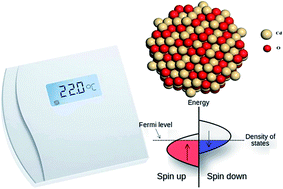Revealing a room temperature ferromagnetism in cadmium oxide nanoparticles: an experimental and first-principles study†
Abstract
We obtain a single cadmium oxide phase from powder synthesized by a thermal decomposition method of cadmium acetate dehydrate. The yielded powder is annealed in air, vacuum, and H2 gas in order to create point defects. Magnetization-field curves reveal the appearance of diamagnetic behavior with a ferromagnetic component for all the powders. Powder annealing under vacuum and H2 atmosphere leads to a saturation magnetization 1.15 memu g−1 and 1.2 memu g−1 respectively with an increase by 45% and 16% compared to the one annealed in air. We show that annealing in vacuum produces mainly oxygen vacancies while annealing in H2 gas creates mainly Cd vacancy leading to room temperature ferromagnetic (RTFM) component together with known diamagnetic properties. Ab initio calculations performed on the CdO nanoparticles show that the magnetism is governed by polarized hybrid states of the Cd d and O p orbitals together with the vacancy.


 Please wait while we load your content...
Please wait while we load your content...